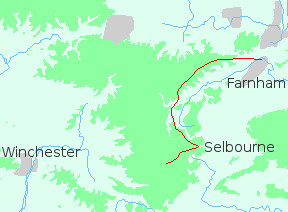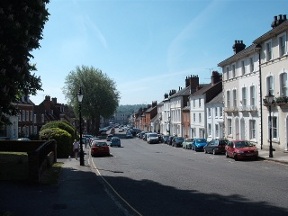
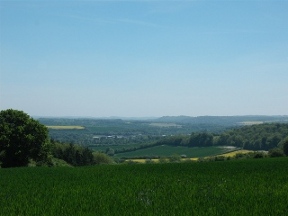
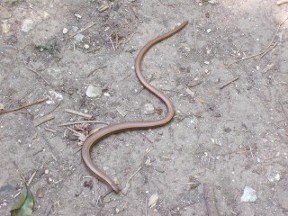
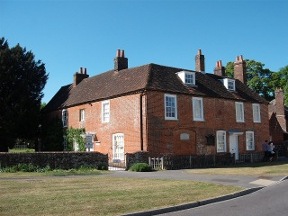
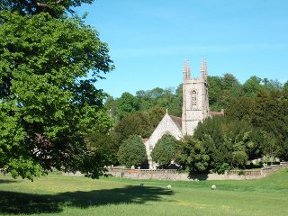
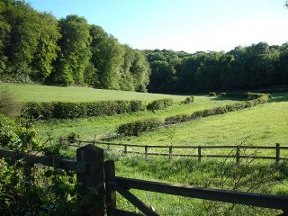
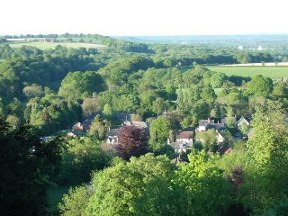
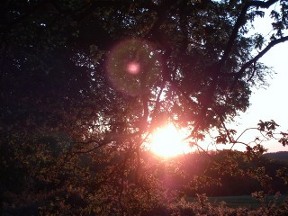
Farnham lies just over the border in Surrey; but its wide streets and red brick are more typical of Hampshire. After a week passed in places further east, to be there felt like coming home.
The town sits at the foot of a narrow ridge, between the wealden clay and the sandy heaths around Aldershot. Westward the ridge broadens, until at Alton it merges with the uplands of mid-Hampshire.
Between Farnham and Alton there's a footpath, the St. Swithun's Way, along the base of the escarpment. However the purpose of the walk was to see as much of the chalk as possible, so with that it mind I kept to the high ground. It was pleasant rather than spectacular, and I was often on roads, but it was enjoyable for all that.
I left Farnham in sunshine, up the broad street leading to the castle. There I turned north-west onto the St. Swithun's Way.
There followed several miles along shaded tracks. The air was light and fresh, virginal spring as yet unsullied by summer. Though it was early in the year the hedgerows were full and tall, their banks bright with flowers. In damp meadows cattle waded through the grass. Overhead the trees rustled gently.
At Wimble Hill I turned off into a lane. It kept to the top of the ridge, heaving with the swell of the chalk. To my left the ground sloped down to the valley where the St. Swithun's Way pursued its course. Ahead I could see the hills beyond Alton, and further still the line of the South Downs.
From the hamlet of Well I found a footpath across fields where hares scuttled over the stony ground. Soon the path became a road, ascending through acres of wind-rippled wheat to the highest point on the ridge. There was little breeze and no shade. I pressed on through the heat, smearing the sweat on my forehead. Finally I crossed the escarpment and descended to Alton. On the way down I came across a slow worm lying sun-drugged on the path.
Alton has the usual facilities of a small town, including a choice of pubs. The one I ended up in turned out to be a sports bar, with TVs on every wall. It was cool, though, and the food was ok. Lunch over I ventured out once more into the glare of the afternoon.
The long main street leads at last to the village of Chawton, where Jane Austen lived. The house, now a musueum, is open to the public and worth a look. The cultural bit out of the way I visited the pub over the road. The drink I bought was reasonably priced, but a glance at the menu made me glad I had dined elsewhere. Perhaps not surprisingly the place makes its money from those not on a budget.
From Chawton I walked out past the church, set among trees, where the novelist's mother and sister are buried. I was making for Selborne, the village where Gilbert White was curate and where he wrote the classic Natural History of Selborne.
As I crossed the downs I came upon a line of electricity pylons and a garish field of rape - both of which which would have bemused the naturalist. Approaching Selborne, though, serene in the evening sunshine, I sensed something of the world he would have known. The village lies at the foot of the Hanger, a wooded hill looking out over the weald. To the east are gardens and orchards; westward the bare chalk upland begins.
There is a museum in the village, but it was closed when I arrived. I found Gilbert White's grave, a simple cross on the north side of the church, and stood beside it for a while. Then I left the village, climbing the zig-zag path he and his brother built, to Selborne Common.
When planning the walk I had hoped to continue south from Selborne to the Meon valley. However there were no obvious paths along the chalk escarpment; and in any case when checking the maps at Selborne I noticed a four-mile section where I would be off the edge of both sheets I was carrying. So I found another way: south-west, through fields and narrow lanes, walking while the light lasted, until I came to the A32.
Across the main road the lane ran into a broad belt of trees. Feeling my way in the darkness I came to a dry plateau, sheltered by overhanging branches. There I passed the night.

